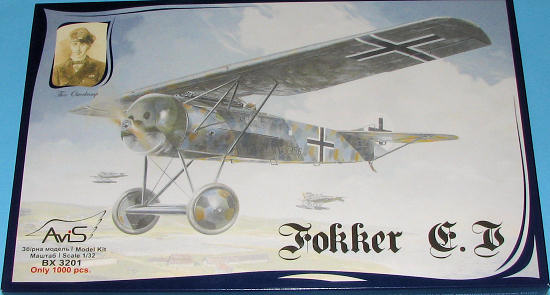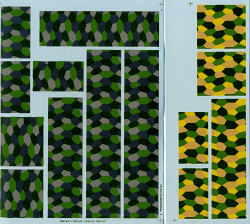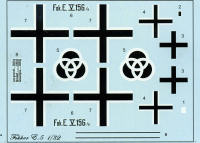
Avis 1/32 Fokker E.V
| KIT #: | 3201 |
| PRICE: | $46.30 from http://www.scale-model-kits.com |
| DECALS: | Two Options |
| REVIEWER: | Scott Van Aken |
| NOTES: | Short run plastic |

| HISTORY |
The first production E.V aircraft were shipped to Jasta 6 in late July. The new monoplane was also delivered to Jasta 1, Jasta 19, Jasta 24 and Jasta 36. Leutnant Emil Rolff scored the first kill in an E.V on August 17, 1918, but two days later he was killed when his aircraft's wing collapsed in flight. After another E.V of Jasta 19 crashed, the Idflieg grounded all E.V aircraft. Pending the investigation of these wing failures, production ceased at the Fokker Flugzeugwerke. According to Fokker, the wing failures were caused by the army technical bureau, which had forced him to modify the original design by over-strengthening the rear main spar. This faulty design allegedly caused the wing to twist and fail. Fokker claimed that this defect was resolved by reverting to his original design.
According to most other accounts, the source of the wing failures lay not in the design, but in shoddy and rushed construction. Fokker had subcontracted construction of the E.V wings to the Gebrüder Perzina Pianoforte Fabrik factory. Due to poor quality control, the spar "caps", forming the upper and lower members of each spar assembly, had been placed too far apart during the fabrication. Because the resulting spars were vertically too large to pass through the ribs, excess material was simply planed away from the exposed upper and lower surfaces of the cap pieces, leaving the assembled spars dangerously weak. Other problems included water damage to glued parts, and pins that splintered the spars, rather than securing them.
Tests showed that when properly constructed, the original E.V wing had a considerable margin of safety. Satisfied that the basic design was safe, the Idflieg authorized continued production after personnel changes and improved quality control measures at the Perzina factory.
Deliveries resumed in October. At the suggestion of the Kogenluft (Kommandierenden General der Luftstreitkräfte), the Idflieg redesignated the modified aircraft D.VIII. Henceforth, the "E." and "Dr." designations were abolished and all fighters received the "D." appellation. The first new examples of the D. VIII started arriving at frontline units late that month and started operations on the 24 October with Jasta 11.
Jasta 5 was granted a D.VIII, and the famed ace Erich Lowenhardt used it for a short time scoring a few victories in the plane. He continued to favor, however, the D.VII.
A total of 289 aircraft were produced. Some reached Holland, Italy, Japan, the United States, and England as trophies, but most were scrapped in accordance with the terms of the Armistice.
| THE KIT |
 This is not the first Fokker E.V done in 1/32. I have been struggling on and off (mostly off) with a Battle Axe kit for the last 5-6 years or so with little progress made. It is typical of bad French short run kits. This one is not.
This is not the first Fokker E.V done in 1/32. I have been struggling on and off (mostly off) with a Battle Axe kit for the last 5-6 years or so with little progress made. It is typical of bad French short run kits. This one is not. the control surface control lines. Entry and exit points on the wings and fuselage for these lines are clearly shown. There is an acetate sheet for instruments and a windscreen. There are NO photo-etch or resin parts to have to deal with.
the control surface control lines. Entry and exit points on the wings and fuselage for these lines are clearly shown. There is an acetate sheet for instruments and a windscreen. There are NO photo-etch or resin parts to have to deal with. Colors are generic and there are two markings options. One is the box art plane of Theo Osterkamp when with Marine Feld Jasta. Though the box art shows the lozenge completely under the wing, the instructions show it only on the leading edge. The other is Friedrich Altenmeir's plane with Jasta 24. This has no wing lozenge, though the upper circumference of the wing is outlined in white. His plane has the three intersecting circles. The decals appear to be very nicely done. I'll leave it to WWI enthusiasts to determine if the colors are correct or not. The instructions show exactly where every section of lozenge is to be applied. It appears you are give sections large enough to install and then cut off excess before it dries.
Colors are generic and there are two markings options. One is the box art plane of Theo Osterkamp when with Marine Feld Jasta. Though the box art shows the lozenge completely under the wing, the instructions show it only on the leading edge. The other is Friedrich Altenmeir's plane with Jasta 24. This has no wing lozenge, though the upper circumference of the wing is outlined in white. His plane has the three intersecting circles. The decals appear to be very nicely done. I'll leave it to WWI enthusiasts to determine if the colors are correct or not. The instructions show exactly where every section of lozenge is to be applied. It appears you are give sections large enough to install and then cut off excess before it dries. | CONCLUSIONS |
Though I'm a wuz when it comes to rigging, this is the sort of WWI model I can handle. I look forward to building it as I've always liked the aircraft. With a production run of 1,000 kits (according to the box), it might be a good idea to grab yours while the getting is good. Though I'd not recommend this to the beginner, those with short run experience or experience where modeling skills are used, should have little trouble with it.
| REFERENCES |
Thanks to http://www.scale-model-kits.com for the preview kit. Get yours today from the link at a considerable savings over retail. If you would like your product reviewed fairly and fairly quickly, please contact the editor or see other details in the